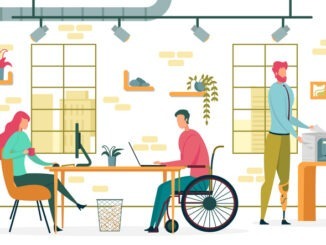Despite progress in workplace accessibility, creating optimal environments for those with invisible disabilities remains an ongoing effort. Here’s how dealers can help to meet these challenges
Although we are making significant progress in creating accessible workspaces for people with disabilities, statistics show that there is still a long way to go in truly achieving optimal work environments for those whose disabilities may not be obvious to see.
In the UK, one in five people live with a disability, however over three quarters of those are considered as ‘invisible’ conditions such as autoimmune diseases, ADHD, chronic pain, and diabetes. Alarmingly, fewer than 5% of employees feel empowered or comfortable disclosing their disabilities to their employers.
For dealers, it is crucial to recognise the impact of unseen disabilities and help customers improve their workplaces to better accommodate these needs. Enhancing work environments for those with invisible disabilities can significantly affect employee performance and well-being. Given that employees may not disclose invisible disabilities, it’s prudent to assume that at least one member of your customer’s team might need additional support or equipment to reach their full potential. Securing the right accommodations can be challenging, as employers may not always be aware of the specific needs related to certain invisible disabilities.
One way in which dealers can support customers is by recommending products that address a range of unique needs. For instance, some invisible disabilities may impact communication and require alternative methods for message delivery. Dealers might suggest products compatible with assistive technologies, such as touchpads, to accommodate these needs.
Overcoming barriers
Assisting customers in identifying and addressing potential workplace barriers is crucial. These barriers can be physical – such as office layout and space flow; resource-based – such as the need for specialised equipment; or cultural – such as preferences for certain workplace methods that may be exclusionary. Mitigating these barriers ensures a more inclusive and effective work environment.
When designing office spaces to accommodate invisible disabilities, dealers should recommend flexible products that offer versatility. For example, adjustable desks can be used at various heights to suit different needs. Additionally, sound boards that can be attached to and removed from desks can help reduce noise pollution for those who are sensitive to sound.
Customers should also be advised to consider how their choices regarding food, cleaning supplies, and hygiene products impact employees with invisible disabilities. For instance, is there designated storage for foods that must be kept separate due to allergies or medical needs? Are there gluten-free snack options available in the office? Ensuring these considerations can help create a more inclusive workplace.
Inclusive environments
One of the biggest challenges with invisible disabilities is the stigma surrounding them. Traditional signage for disabled facilities often depicts a wheelchair user, which can overlook those with non-visible disabilities. Many workplaces are now opting for more inclusive signage that indicates spaces are accessible to individuals with all types of disabilities, whether visible or not. Dealers can support companies by providing a variety of inclusive signage options, including designs with large print fonts and multiple languages.
Often, creating a more inclusive environment doesn’t require significant investment but rather thoughtful adjustments and accessible options. By highlighting cost-effective strategies, such as flexible office equipment and inclusive signage, dealers can reassure customers that accommodating invisible disabilities can be achieved with minimal expense while making a meaningful impact on employee well-being and productivity.




Be the first to comment